If you missed this year’s virtual summit, we’ve got you covered. Here’s a recap of what we learned during each day of the jam-packed conference.
 Friday highlights: Customer service lessons from Disney
Friday highlights: Customer service lessons from Disney
Following the afternoon workshops on product design and member engagement, main conference attendees were invited to join our virtual networking session, chat with one another, and enjoy a keynote presentation by “customer service guru” Louie Gravance.

A former Disney Institute professor, Gravance showed us why he is often referred to as “the guy who can make the Disney service concepts work outside of Disney.” He dazzled us with a presentation on how to create superhero service moments by maximizing every transaction, practicing team training techniques, and following an action plan for performance assessment.
While the word “Disney” is not listed in the dictionary as an adjective, Gravance said people understand what a Disney experience is and isn’t. The same, he said, is true for any organization you work for. The goal when you want to create a service culture, he said, is to think about the story you want to tell, the language and behavior you use to tell it, and then offer recognition when the story is told.
“Every transaction is an emotional reaction,” Gravance explained, noting it’s our responsibility to help create a culture and great moments in the health care industry.
His advice: If the customers in front of you need to be served, serve them. Do what’s important in the moment. “Service is a superpower and transcends your experience,” he said.
But that doesn’t mean that when you reignite your service culture, you’ll hit a home run every time you take the bat. “We typically ask people to deliver service aiming for the head as opposed to the heart,” he said. “Think of broader issues. Instead of person to person, think about moment to moment.”
While it may be difficult to stay focused on intentions when we must handle tasks every day, Gravance urged attendees to take a step back and think about the great service moments they experienced or gave to customers.
“I bet you’ve never gone home and stopped to realize the emotional impact you may have had on someone that day,” he said, noting that “service is indeed a superpower that you can arm your teammates with and create magical moments in any industry, especially those in health care.”
Monday highlights: Deft research’s 2020 AEP shopping study, lessons learned
The conference jumped into an energetic keynote with Customer Care Expert Dean Lindsay, who shared what it takes to rise to next level service in 2021. Lindsay discussed the value in positioning your products and services as progress rather than change; the six Ps of progress all customers, clients, members, and co-workers desire; and the role self-optimization plays in success.
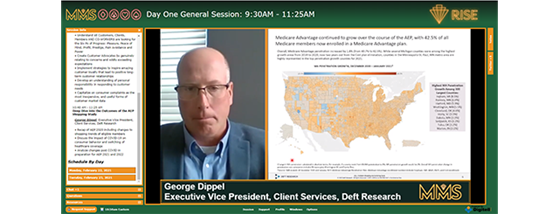
We then heard from Deft Research’s George Dippel, executive vice president, client service, who provided a deep dive into the outcomes of the research firm’s 2020 AEP shopping study that surveyed 3,478 seniors in December 2020. Dippel’s annual presentation is a highlight of the conference and he did not disappoint. Among the key findings:
- Seniors were hesitant to switch carriers during the pandemic. Nearly a quarter of respondents said they were more likely to stay loyal to their carrier or type of coverage due to COVID-19, with hardly anyone indicating that it will push them to change.
- However, members who had been COVID-19 positive or were exposed to it were more likely to switch plans within the same insurer than those who did not contract COVID-19. Dippel expects that seniors dealing with an infection after the 2020 AEP may contribute to pent-up switching demand during the 2022 AEP, maybe as early as the 2021 OEP.
- Carriers and plans that sent COVID/Flu kits to their members got a boost in loyalty and brand enhancement. Dippel said that carriers may see a benefit in similar forms of outreach in the future, such as post-surgery wellness kits or preventive screening prep kits.
- Those who switched into a new 2021 MA plan were more likely to report access to many supplemental benefits than non-switchers were. Top benefits were telehealth, eyewear allowance, hearing aid allowance, and over-the-counter pharmacy allowance.
- Members in their first year with a plan were two times more likely to switch out than those with one to five years, and about three times more likely to switch out than those with more than five years. Dippel said this indicates the need to apply retention efforts to new members, especially as the industry distances itself from face-to-face selling.
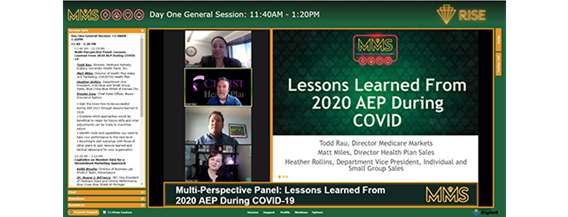
Continuing the AEP conversation, we heard from panelists about the lessons they learned from 2020 AEP during COVID-19. Todd Rau, director of Medicare for Indiana University Health Plans, Matt Miles, director of health plan sales and marketing for CHRISTUS Health Plan, and Heather Rollins, department vice president of individual and small group sales at Blue Cross and Blue Shield of Kansas City (Blue KC), shared how they differentiate themselves in the current market landscape, and how they pivoted quickly when they were unable to meet with potential members face-to-face and came up with other ways to interact with them, such as at the end of driveways, Zoom meetings, and kiosks in stores. Strategies that helped build brand loyalty: Blue KC sent members branded masks and hand sanitizer and called them on their birthdays to wish them a Happy Birthday, check on their wellbeing, and see if they needed anything.
Next, we heard from Keith Brophy, director of business lab product team, Advantasure, and Duane DiFranco, M.D., vice president of Medicare stars and clinical performance, Blue Cross Blue Shield of Michigan (BCBSM), as they discussed how to capitalize on member data for a streamlined marketing approach. Brophy and Dr. DiFranco shared an inside look at the successful approach Advantasure and BCBSM took to guide members and prospects to the plan that suits them best using converging techniques between AI learning, behavioral science, and member and clinical data; micro-segmenting for targeted communication; and a persuasive platform with multiple digital “nudges” that resonate with the member.
During an exclusive bonus session over lunch, Kathleen Ellmore, managing director, Engagys, discussed the results of the RISE-Engagys annual survey on health care consumer engagement practices. The survey, now in its fifth year, drew 100 responses from health plans. Among the findings:
- Plans report an increased emphasis on member engagement and consumer-centric roles. But risk adjustment has taken a backseat, perhaps because it is becoming less of a stand-alone activity, Ellmore noted.
- Executive participation continues to grow along with budgets for consumer engagement.
- The top departmental priorities for 2020 were the ability to increase multi-channel capabilities, capture and act on social determinants of health (SDoH), and improve collaboration with providers.
- Plans report the most success with SDoH interventions involving behavioral health, transportation, and food insecurity.
- The main challenge to meeting engagement goals is the lack of resources to execute on strategy Those resources include budget, current environmental factors, provider engagement, and staffing.
Delegates then split into three concurrent tracks for the afternoon: Marketing, Sales, and Innovative Strategies. Industry experts discussed hot-button topics including marketing Medicare during COVID trauma; technology, tools, and strategy to guarantee success; lessons on improving digital marketing performance during difficult times; how to capitalize on digital marketing for the “younger” age in’s; how to boost online enrollment through member engagement and guidance; and marketing strategies for “late to retire” membership.
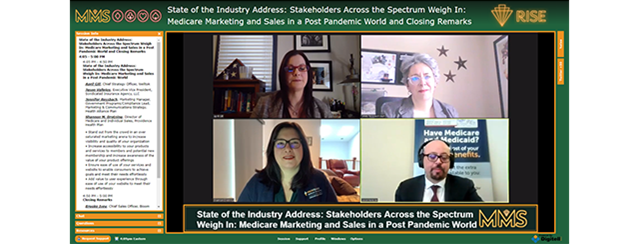
We reunited for a state of the industry address as stakeholders across the spectrum weighed in on Medicare marketing and sales in a post-pandemic world. The panel discussed strategies to stand-out from the crowd, including social media integration, niche community marketing, and print advertising; marketing tools that have come back from the dead, such as QR codes and radio; and new tools that will be carried into the future, including virtual bingo nights and doc talks, online enrollment tools, and weekly team huddles.
RELATED: Top 3 tips for Medicare marketing and sales in a post-pandemic world
After a busy day, delegates, speakers, and vendors were invited to enjoy on-camera networking in the virtual lobby for the face-to-face networking experience we all know and love at a RISE event.
Tuesday highlights: How to compete against the nationals, regulatory changes to monitor
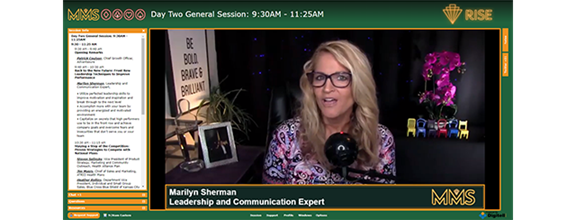
Our first session of the day took us back to the new future with Leadership and Communication Expert Marilyn Sherman, who spoke about the shift to lifestyle COVID has caused, coping skills for the new future, and how to achieve a front row seat in both your professional and personal lives using the S.E.A.T. strategies:
- See the outcome you desire
- Energy focused toward your vision
- Attitude of positivity
- Tenacity at full capacity
Through compelling stories of courage, compassion, and kindness, Sherman reminded us of the role our leadership plays in not only our own lives but others. “When you change your seat, you change your life,” she said. “More than that, when you change your seat, you have an opportunity to change someone else’s life.”
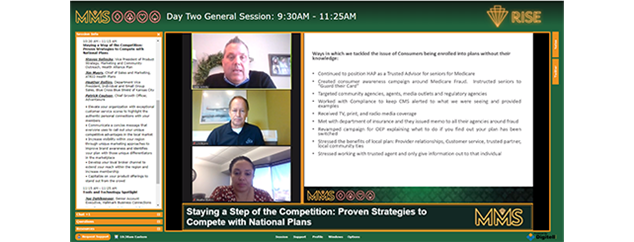
We learned how to compete with the national health plans thanks to Steven Selinsky of Health Alliance Plan, Jim Myers of ATRIO Health Plans, and Heather Rollins of Blue Cross and Blue Shield of Kansas City (Blue KC), who shared the successful strategies their organizations used this year to differentiate themselves. For Myers, that meant a marketing campaign that demonstrated to seniors that the organization loved Medicare and the beneficiaries they served. That message was also spread via a team of member ambassadors. “I heart my Medicare became the essence of who we are,” he said. “It was very simple and attention-getting.” Selinsky said his organization doesn’t try to duplicate the benefits that national plans offer, instead it focuses on the ties it has to the communities it serves and being a trusted partner and adviser to members. Part of that strategy was a consumer awareness campaign around Medicare fraud, an effort that got the attention of local press. Rollins said Blue KC makes sure the benefits it offers remains consistent year to year and tresses its ties to the local community. The regional health plan also focuses on member engagement and contacting members to check on their wellbeing throughout the year. During onboarding, Blue KC also works with members to make sure they understand their benefits and know how to access them.
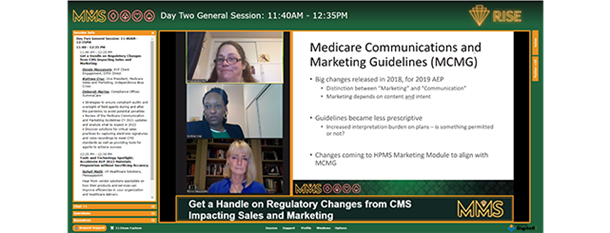
Next, we learned about regulatory changes from CMS that impact sales and marketing during a panel discussion moderated by Renee Mezzanotte, exec VP of DMW Direct. Deborah Marine, J.D., a compliance officer with SummaCare, provided an overview on agent and broker oversight; the big changes CMS released in 2018 for the 2019 AEP; and marketing issues to watch out for, including the difference between provider-initiated activities and plan-initiated activities, nominal gifts, and educational events versus sales/marketing events. Her message: The CMS changes mean the burden is on the plan to get it right with a lot less guidance about the right interpretation. Kortney Cruz: VP Medicare sales & marketing for Independence Blue Cross, offered five tips to ensure compliance during a socially-distanced AEP:
- Ensure your team understands CMS’ Medicare Communications and Marketing Guidelines (MCMGs)
- Plan and lay the groundwork with all internal stakeholders but particularly legal and compliance
- Monitor constantly
- Provide support to frontline staff
- Be transparent
After networking opportunities in the virtual lobby, delegates could choose to participate in two of eight roundtable discussions. Topics included:
- Marketing to care givers
- A new way to view your ANOC + EOC
- Maximize visibility through Facebook, YouTube, and Webinars
- Innovative strategies for outside sales agents
- See well. Be well. How vision health impacts overall wellness for your seniors
- Preparing for the new normal with a hybrid enrollment approach
- Member engagement and satisfaction strategies to improve retention
- Tactics to engage members throughout their lifecycle to improve outcomes
The afternoon continued with three concurrent tracks on marketing innovations, sales innovations, and sale success and product design. Topics throughout the tracks included advanced web techniques to optimize SEO, improve user experience, and boost visibility; how to maximize member experience and satisfaction through in-home outpatient treatment; how to create the right supplemental benefit mix to stay ahead; how to maximize ROI through your marketing mix pre- and post- pandemic; closing gaps to re-engage members before time runs out; and key techniques to gain new enrollees from Medicare Supplement membership.
We joined back together for an interactive “Guys, we messed up…” discussion filled with transparencies and lessons learned from industry specialists and fellow attendees. During the open mic forum, peers and panelists shared their unsuccessful strategies that have become learning tools. “It’s okay to fail,” said Jotham Cortez, sr. director, sales operations, Essence Healthcare. “Sometimes we think it has to be perfect, and it really doesn’t. We can have grace for ourselves, our teammates, our stakeholders.”

We ended the day with a state of the industry address with Laura Aiello, director of business development and strategic partnerships, LifeStation, Blue Cross KC’s Heather Rollins, and Hank Osowski, managing partner, Strategic Health Group. Osowski said that the health care industry historically has been slow to respond to issues compared to other industries. But he has been proud of the way health plans pivoted quickly this year to ensure their most vulnerable members had access to care and rapidly adopted telehealth technologies. Rollins agreed, and said that the biggest lesson COVID-19 has taught us is the need to be flexible in everything we do. “Any interaction, any strategy, any creation or solution, you have to be flexible.”
Editor’s note: Virtual was great but next year we are headed back to Vegas to meet in person! Save the date to join us for the Medicare Marketing & Sales Summit 2022, February 21-22, 2022 at Caesars Palace in Las Vegas.
